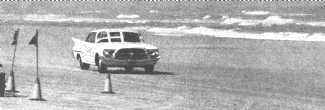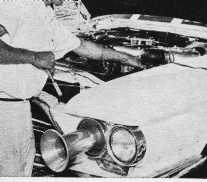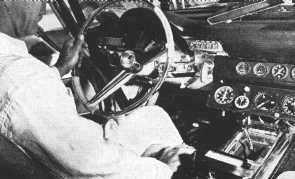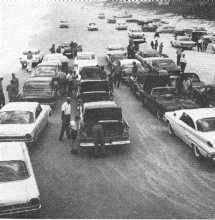![]()
![]()
Dateline: Daytona TRIALS ON THE BEACH
MEANWHILE, ON THE BEACH, the big noise was
Andy Granatelli, the  Santa
Monica, Calif., supercharger manufacturer — or more precisely, Granatelli’s
loaded-for-bear Chrysler 300-F. As is often the case at NASCAR’s annual Flying
Mile trials, there was a postponement of activity while officials
waited for the sun and sea to hone the white ‘sands to proper smoothness for
top speed runs, but for Granatelli the wait was well worth it. Ah seemed in
order the morning of February 18, and Granatelli was among the first to roll his
big white bomb to the starting line. There was a last-minute check of the twin
superchargers which had come from his own Paxton Products plant.
Santa
Monica, Calif., supercharger manufacturer — or more precisely, Granatelli’s
loaded-for-bear Chrysler 300-F. As is often the case at NASCAR’s annual Flying
Mile trials, there was a postponement of activity while officials
waited for the sun and sea to hone the white ‘sands to proper smoothness for
top speed runs, but for Granatelli the wait was well worth it. Ah seemed in
order the morning of February 18, and Granatelli was among the first to roll his
big white bomb to the starting line. There was a last-minute check of the twin
superchargers which had come from his own Paxton Products plant.  and
then Granatelli was on his way, steadily increasing his speed as he buzzed
through the two miles which competitors are allowed before hitting the Flying
Mile traps. The first run was south, against a wind estimated at about 10
mph. Former Indianapohis driver Granatelli handled it like a trip to the corner
market, blasting smoothly through the clocks at 165.441. The run north, with the
wind at his back, was the big one. However The clocks showed a stunning 179.472
for a stock car record two-way average of 172.166. NASCAR had classified the
machine in its Experimental division, which meant an end to Texan Karol Miller's
old mark of 153.061 in that class with a Ford. As a production car, the 300-F is
officially tagged with 400 hp at 5600 rpm. With the two superchargers,
Granatelli figures the 413-inch engine was delivering better than 800
and
then Granatelli was on his way, steadily increasing his speed as he buzzed
through the two miles which competitors are allowed before hitting the Flying
Mile traps. The first run was south, against a wind estimated at about 10
mph. Former Indianapohis driver Granatelli handled it like a trip to the corner
market, blasting smoothly through the clocks at 165.441. The run north, with the
wind at his back, was the big one. However The clocks showed a stunning 179.472
for a stock car record two-way average of 172.166. NASCAR had classified the
machine in its Experimental division, which meant an end to Texan Karol Miller's
old mark of 153.061 in that class with a Ford. As a production car, the 300-F is
officially tagged with 400 hp at 5600 rpm. With the two superchargers,
Granatelli figures the 413-inch engine was delivering better than 800  horses at
6800 rpm.
horses at
6800 rpm.
Since Chrysler introduced its "300"
series in 1955, the strictly stock class runs have also been dominated by that
machine, and 1961 was no exception. Gregg Ziegler of Elgin, Illinois, used a
300-G for a two-way Flying Mile run average of 143.027, best among the
"showroom" stockers. Ziegler set the old record last year at 144.927
in a 300-F. Two drivers, Harry Faubel of Chambersburg, Pa., and Ken Fisher of
Hamburg, N.Y., actually bettered Ziegier’s speed but were among 10 who were
disqualified. Faubel and Fisher were both erased because the decorative chrome
molding on their windshields ripped lose and blew off during the runs. The rules
state that a car must complete runs in exactly the same condition as it was when
inspected at the starting line, and this unfortunately disqualified the car.
Century Club (one-way) runs were topped by Tommy Charles of Birmingham, Ala., in
one of the oldest (1958 model) Corvettes entered. His speed: 141.955. Only one
record fell in acceleration Runs (one mile from a dead stop), that in Class
Four, where Robert Loudon of Aurora, Iii., zipped his ‘61 Rambler through at
80.213, shattering the old mark of 71.785 set in 1957 by a ‘57 Rambler.
ripped lose and blew off during the runs. The rules
state that a car must complete runs in exactly the same condition as it was when
inspected at the starting line, and this unfortunately disqualified the car.
Century Club (one-way) runs were topped by Tommy Charles of Birmingham, Ala., in
one of the oldest (1958 model) Corvettes entered. His speed: 141.955. Only one
record fell in acceleration Runs (one mile from a dead stop), that in Class
Four, where Robert Loudon of Aurora, Iii., zipped his ‘61 Rambler through at
80.213, shattering the old mark of 71.785 set in 1957 by a ‘57 Rambler.
Back
to Index
![]() [email protected]
[email protected]
![]()